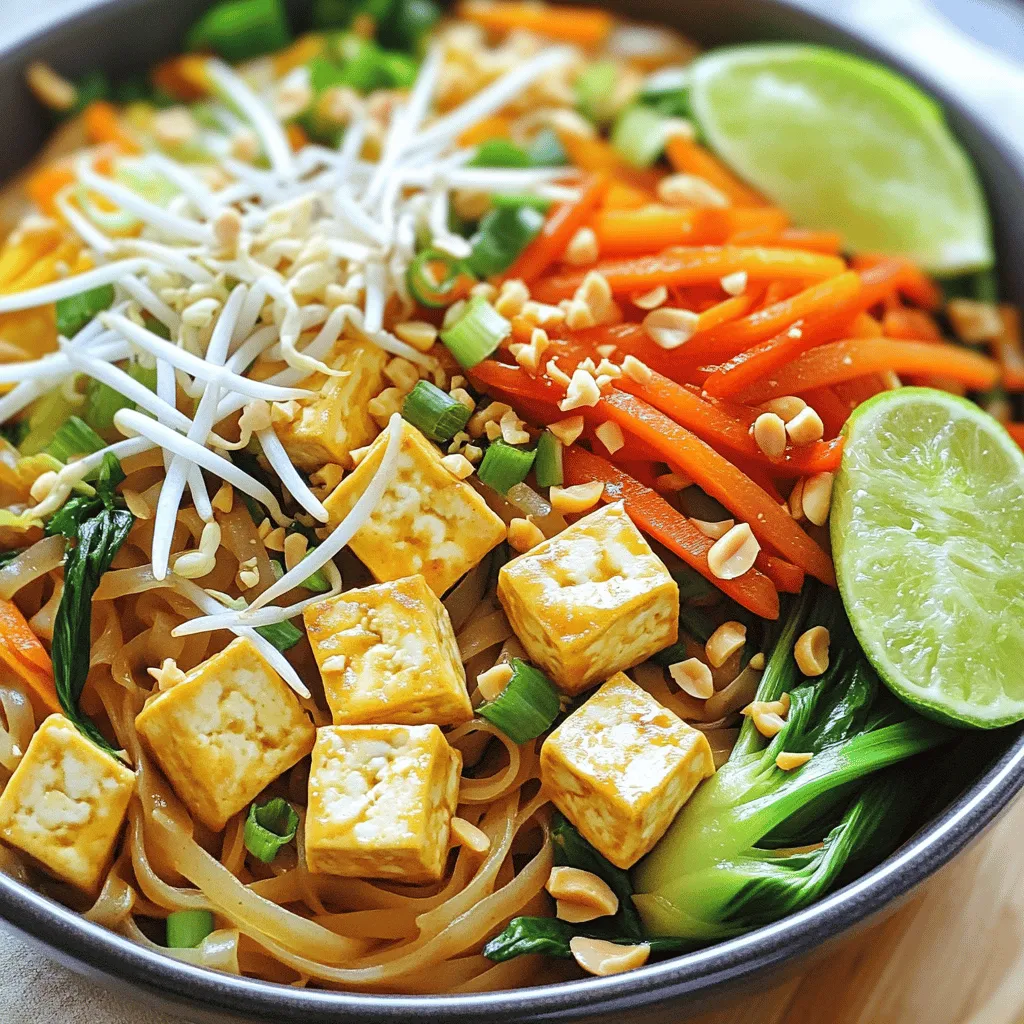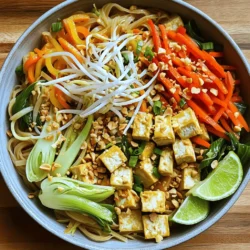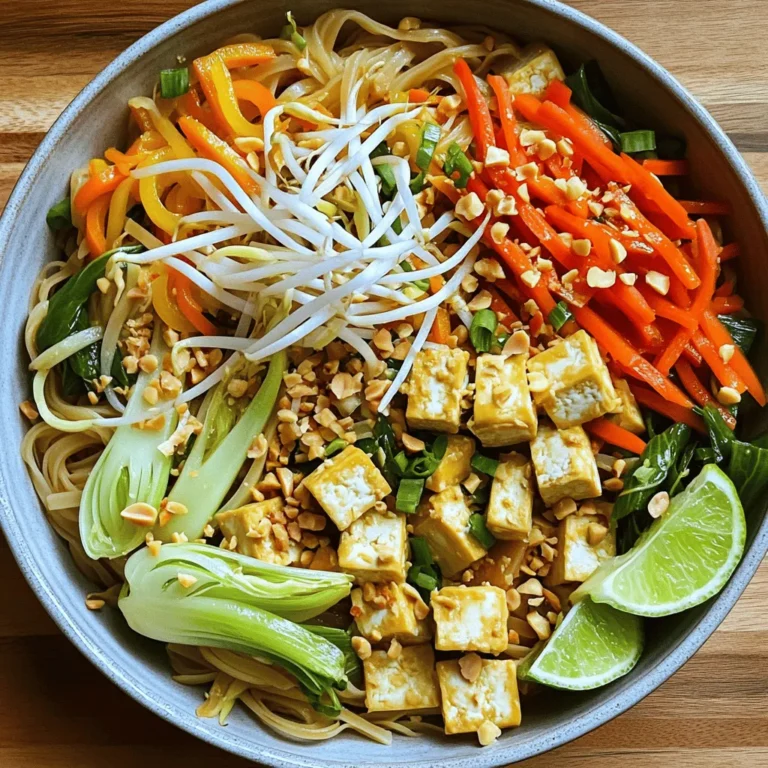If you crave a quick, tasty dinner, Vegetable Pad Thai is your answer. This dish bursts with flavor and colors, making it perfect for your weeknight meals. I’ll share easy steps and smart tips to make sure your Pad Thai shines every time. With fresh veggies and simple ingredients, you’ll have a meal that pleases everyone. Ready to cook? Let’s dive into this delightful recipe!
Ingredients
Complete List of Ingredients for Vegetable Pad Thai
To make a tasty Vegetable Pad Thai, gather these ingredients:
– 8 oz rice noodles
– 2 tablespoons vegetable oil
– 2 cloves garlic, minced
– 1 cup firm tofu, cubed
– 1 cup bean sprouts
– 1 carrot, julienned
– 1 red bell pepper, thinly sliced
– 1 cup bok choy, chopped
– 3 green onions, sliced
– 2 tablespoons soy sauce
– 2 tablespoons tamarind paste
– 1 tablespoon sugar
– 1/2 teaspoon chili powder (optional)
– Crushed peanuts and lime wedges for garnish
This list covers all you need for a delicious meal that bursts with flavor.
Fresh vs. Frozen Ingredients
Using fresh ingredients often gives the best taste and texture in Vegetable Pad Thai. Fresh veggies like bell peppers and bok choy hold their crunch and flavor. However, frozen options work well too. They can save you time and still taste great.
If you choose frozen, pick ones without added sauces. They should be simple vegetables. You can thaw them before cooking or toss them right into the skillet. Just add a minute to the cooking time.
Ingredient Substitutions for Dietary Preferences
You can easily customize Vegetable Pad Thai to fit your diet. If you need it vegan, keep the tofu and skip any animal products. For gluten-free meals, swap soy sauce with tamari.
Here are some more substitutions you can make:
– Tofu: Use tempeh or chickpeas for protein.
– Rice noodles: Try zucchini noodles or gluten-free pasta.
– Veggies: Feel free to add or change vegetables, like broccoli or snap peas.
These swaps keep your dish flavorful while meeting your needs.
Step-by-Step Instructions
Preparation of Noodles
Start by soaking the rice noodles in hot water. Let them sit for about 20 minutes. They should soften nicely. Drain the noodles and set them aside. This step is key for a good texture.
Cooking the Tofu and Vegetables
In a large skillet or wok, heat the vegetable oil over medium-high heat. Add the minced garlic and sauté it for 30 seconds. You want to smell the garlic but not burn it. Next, add the cubed tofu. Cook it until golden brown on all sides. This takes about 5 to 7 minutes.
Once the tofu is ready, stir in the julienned carrot and thinly sliced red bell pepper. Cook these for another 2 to 3 minutes. They should be slightly tender but still crisp. Now, add the chopped bok choy and bean sprouts. Stir-fry for about 2 more minutes.
Combining Ingredients and Final Touches
Push the vegetable mix to one side of the skillet. Add the soaked noodles to the other side. Pour in the soy sauce, tamarind paste, and sugar. If you like spice, sprinkle in the chili powder. Stir everything together well.
Finally, add the sliced green onions. Mix until the noodles and veggies heat through. This takes about 2 minutes. Remove from heat. Serve hot and garnish with crushed peanuts and lime wedges. Don’t forget to squeeze the lime over your dish before eating!
Tips & Tricks
How to Perfectly Soak Rice Noodles
To soak rice noodles, start with hot water. Use a bowl and pour the hot water over the noodles. Let them soak for about 20 minutes. Check if they are soft. If they are, drain them and set aside. This step makes your noodles more tender and easy to stir-fry later. Don’t soak them too long, or they may fall apart.
Making Homemade Pad Thai Sauce
Making Pad Thai sauce at home is easy. You need just a few key ingredients: soy sauce, tamarind paste, and sugar. Mix two tablespoons of soy sauce, two tablespoons of tamarind paste, and one tablespoon of sugar in a bowl. Stir until the sugar dissolves. This sauce gives your dish a sweet and tangy flavor. Adjust the taste by adding chili powder for a kick, if you like heat.
Garnishing Ideas for Presentation
Garnishing your Vegetable Pad Thai adds color and crunch. Use crushed peanuts for a nutty flavor. Sprinkle them on top just before serving. Lime wedges add a fresh burst when squeezed. You can also add sliced green onions for a pop of green. These simple touches make your dish look inviting and taste even better.

Variations
Adding Protein: Tofu Alternatives
Tofu is a great source of protein for Vegetable Pad Thai. If you want a change, try chickpeas or tempeh. Both options add texture and flavor. You can also use seitan for a more meat-like bite. Just remember to adjust cooking times. Cook chickpeas until heated. For tempeh, sauté until golden. Seitan cooks quickly, so add it near the end.
Gluten-Free Options for Pad Thai
To make Vegetable Pad Thai gluten-free, swap soy sauce for tamari. Tamari offers a similar taste without gluten. Also, check your rice noodles. Most are gluten-free, but it’s good to verify. You can even try zucchini noodles for a fresh twist. They add crunch and color to your dish.
Adjusting Spice Levels for Different Palates
Spice levels can really change your meal. If you like it mild, skip the chili powder. You can also reduce it to suit kids or those who dislike heat. For a spicy kick, add fresh chili or chili flakes on top. Always taste as you go. This helps you find the right balance. You can also serve lime wedges on the side. This adds a fresh zing that brightens the flavors.
Storage Info
How to Store Leftover Vegetable Pad Thai
To keep your Vegetable Pad Thai fresh, store it in an airtight container. Make sure it cools down before putting it in the fridge. You can keep it for up to three days. If you want to enjoy it later, place it in the freezer.
Reheating Tips for Best Taste
For the best taste, reheat your Vegetable Pad Thai on the stove. Add a splash of water or soy sauce to help it heat evenly. Stir it often to prevent sticking. Heat it until it’s hot but not too dry. You can also use a microwave. Just cover it to keep moisture in.
Freezing for Future Meals
To freeze your Vegetable Pad Thai, portion it into containers. Leave some space at the top for expansion. It can last for about one month in the freezer. When you’re ready to eat, thaw it overnight in the fridge. Reheat it as mentioned above for the best results.
FAQs
What is the origin of Pad Thai?
Pad Thai comes from Thailand. It became popular in the 1930s. The dish mixes rice noodles, veggies, and often meat or tofu. It reflects Thai culture and flavors. The dish gained fame for its balance of sweet, salty, and sour tastes.
Can I make Vegetable Pad Thai without tamarind?
Yes, you can. If you skip tamarind, use lime juice instead. Lime gives a fresh, tangy taste. You can also add a bit of vinegar for extra sourness. Adjust sugar to keep balance.
How long does homemade Pad Thai last in the fridge?
Homemade Pad Thai lasts about 3 to 4 days in the fridge. Store it in an airtight container. This keeps the flavors fresh. When you reheat, add a splash of water to avoid dryness.
What can I serve with Vegetable Pad Thai?
Serve Vegetable Pad Thai with a side of spring rolls or a fresh salad. You can also pair it with a light soup. For drinks, try iced tea or coconut water. These options will enhance your meal.
This article covered how to make a delicious Vegetable Pad Thai. We went over key ingredients, cooking steps, and useful tips. You learned about substitutions for diets and how to store leftovers. Each section aimed to help you create a tasty meal.
Remember, cooking is all about fun and trying new things. With practice, you’ll make your perfect Pad Thai. Enjoy your cooking journey!


